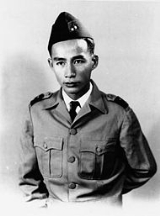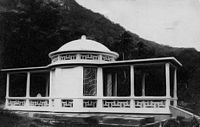
Trinh Minh The
Encyclopedia
Trình Minh Thế was a Vietnam
ese nationalist and military
leader during the end of the First Indochina War
and the beginning of the Vietnam War
.
religion. He was trained in military officer school by the Japan
ese Kempeitai
when Japan began using Cao Đài paramilitary
troops. By 1945 he was an officer in the Cao Đài militia.
In June 1951, Thế broke from the Cao Đài hierarchy and took about two thousand troops with him to form his own militia, the Lien Minh, devoted to combating both the French and the Việt Minh
. Thế’s father and one of his brothers formed their own military group in the Lien Minh and were later killed by Việt Minh
in combat.
Thế’s forces were implicated in a series of terrorist
bombings in Saigon from 1951 to 1953—which were blamed on communists at the time—and may also have been responsible for the assassination of the French General Chanson at Sa Đéc in 1951.
In 1954, United States
military advisor Edward Lansdale
, charged with propping up the regime of Ngô Đình Diệm
, negotiated with Thế to use his militia to back up Diệm and the ARVN. On February 13, 1955, Thế’s troops were officially integrated into the South Vietnam
ese army, where he assumed the rank of general
. He led the Lien Minh on a triumphal march into Saigon.
Through Lansdale, the U.S. continued to fund Thế and other Caodaist groups. However, as the South Vietnamese government faltered, many of the militia leaders declared their open opposition to Diệm and began an attempted coup. Thế’s loyalties at this point were unclear, and it was also unclear whether the U.S. intended to support Diệm against the rebels; some said that Thế might be a realistic replacement for Diệm. However, when the Lien Minh entered Saigon again it appeared to be in response to Lansdale’s last-minute call for them to protect Diệm.
On May 3, 1955, while driving in an open vehicle, Thế was shot in the back of the head by a sniper. The murder was unsolved, with some blaming the French (who had vowed to kill Thế for years) and others blaming the South Vietnamese government.
 Trinh Minh Son, Thế’s son, claims that his father was killed, from a pistol with its muzzle against his head. He also claims that he was shot by two bullets, not one bullet as stated by official media. His son says it was possible that Thế was assassinated by the South Vietnamese government to prevent him from forming the basis of a possible future opposition to the government.
Trinh Minh Son, Thế’s son, claims that his father was killed, from a pistol with its muzzle against his head. He also claims that he was shot by two bullets, not one bullet as stated by official media. His son says it was possible that Thế was assassinated by the South Vietnamese government to prevent him from forming the basis of a possible future opposition to the government.
Vietnam
Vietnam – sometimes spelled Viet Nam , officially the Socialist Republic of Vietnam – is the easternmost country on the Indochina Peninsula in Southeast Asia. It is bordered by China to the north, Laos to the northwest, Cambodia to the southwest, and the South China Sea –...
ese nationalist and military
Military
A military is an organization authorized by its greater society to use lethal force, usually including use of weapons, in defending its country by combating actual or perceived threats. The military may have additional functions of use to its greater society, such as advancing a political agenda e.g...
leader during the end of the First Indochina War
First Indochina War
The First Indochina War was fought in French Indochina from December 19, 1946, until August 1, 1954, between the French Union's French Far East...
and the beginning of the Vietnam War
Vietnam War
The Vietnam War was a Cold War-era military conflict that occurred in Vietnam, Laos, and Cambodia from 1 November 1955 to the fall of Saigon on 30 April 1975. This war followed the First Indochina War and was fought between North Vietnam, supported by its communist allies, and the government of...
.
Biography
Thế was born in Tây Ninh Province and raised in the Cao ĐàiCao Dai
Cao Đài is a syncretistic, monotheistic religion, officially established in the city of Tay Ninh, southern Vietnam, in 1926. Đạo Cao Đài is the religion's shortened name, the full name is Đại Đạo Tam Kỳ Phổ Độ...
religion. He was trained in military officer school by the Japan
Japan
Japan is an island nation in East Asia. Located in the Pacific Ocean, it lies to the east of the Sea of Japan, China, North Korea, South Korea and Russia, stretching from the Sea of Okhotsk in the north to the East China Sea and Taiwan in the south...
ese Kempeitai
Kempeitai
The was the military police arm of the Imperial Japanese Army from 1881 to 1945. It was not an English-style military police, but a French-style gendarmerie...
when Japan began using Cao Đài paramilitary
Paramilitary
A paramilitary is a force whose function and organization are similar to those of a professional military, but which is not considered part of a state's formal armed forces....
troops. By 1945 he was an officer in the Cao Đài militia.
In June 1951, Thế broke from the Cao Đài hierarchy and took about two thousand troops with him to form his own militia, the Lien Minh, devoted to combating both the French and the Việt Minh
Viet Minh
Việt Minh was a national independence coalition formed at Pac Bo on May 19, 1941. The Việt Minh initially formed to seek independence for Vietnam from the French Empire. When the Japanese occupation began, the Việt Minh opposed Japan with support from the United States and the Republic of China...
. Thế’s father and one of his brothers formed their own military group in the Lien Minh and were later killed by Việt Minh
Viet Minh
Việt Minh was a national independence coalition formed at Pac Bo on May 19, 1941. The Việt Minh initially formed to seek independence for Vietnam from the French Empire. When the Japanese occupation began, the Việt Minh opposed Japan with support from the United States and the Republic of China...
in combat.
Thế’s forces were implicated in a series of terrorist
Terrorism
Terrorism is the systematic use of terror, especially as a means of coercion. In the international community, however, terrorism has no universally agreed, legally binding, criminal law definition...
bombings in Saigon from 1951 to 1953—which were blamed on communists at the time—and may also have been responsible for the assassination of the French General Chanson at Sa Đéc in 1951.
In 1954, United States
United States
The United States of America is a federal constitutional republic comprising fifty states and a federal district...
military advisor Edward Lansdale
Edward Lansdale
Edward Geary Lansdale was a United States Air Force officer who served in the Office of Strategic Services and the Central Intelligence Agency. He rose to the rank of Major General and was awarded the Distinguished Service Medal in 1963. He was an early proponent of more aggressive US actions in...
, charged with propping up the regime of Ngô Đình Diệm
Ngo Dinh Diem
Ngô Đình Diệm was the first president of South Vietnam . In the wake of the French withdrawal from Indochina as a result of the 1954 Geneva Accords, Diệm led the effort to create the Republic of Vietnam. Accruing considerable U.S. support due to his staunch anti-Communism, he achieved victory in a...
, negotiated with Thế to use his militia to back up Diệm and the ARVN. On February 13, 1955, Thế’s troops were officially integrated into the South Vietnam
South Vietnam
South Vietnam was a state which governed southern Vietnam until 1975. It received international recognition in 1950 as the "State of Vietnam" and later as the "Republic of Vietnam" . Its capital was Saigon...
ese army, where he assumed the rank of general
General
A general officer is an officer of high military rank, usually in the army, and in some nations, the air force. The term is widely used by many nations of the world, and when a country uses a different term, there is an equivalent title given....
. He led the Lien Minh on a triumphal march into Saigon.
Through Lansdale, the U.S. continued to fund Thế and other Caodaist groups. However, as the South Vietnamese government faltered, many of the militia leaders declared their open opposition to Diệm and began an attempted coup. Thế’s loyalties at this point were unclear, and it was also unclear whether the U.S. intended to support Diệm against the rebels; some said that Thế might be a realistic replacement for Diệm. However, when the Lien Minh entered Saigon again it appeared to be in response to Lansdale’s last-minute call for them to protect Diệm.
On May 3, 1955, while driving in an open vehicle, Thế was shot in the back of the head by a sniper. The murder was unsolved, with some blaming the French (who had vowed to kill Thế for years) and others blaming the South Vietnamese government.


